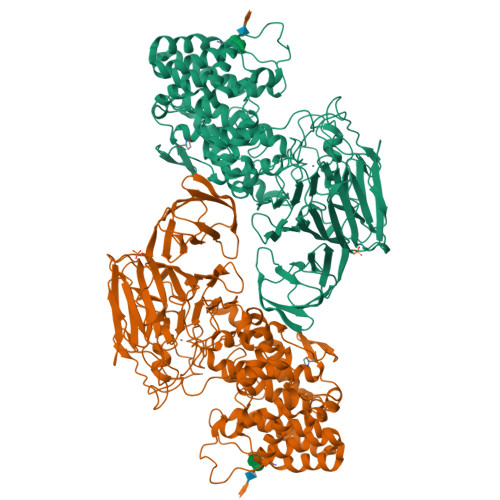Crystal Structure of Heparinase II from Pedobacter heparinus and Its Complex with a Disaccharide Product.
Shaya, D., Tocilj, A., Li, Y., Myette, J., Venkataraman, G., Sasisekharan, R., Cygler, M.(2006) J Biological Chem 281: 15525-15535
- PubMed: 16565082
- DOI: https://doi.org/10.1074/jbc.M512055200
- Primary Citation of Related Structures:
2FUQ, 2FUT - PubMed Abstract:
Heparinase II depolymerizes heparin and heparan sulfate glycosaminoglycans, yielding unsaturated oligosaccharide products through an elimination degradation mechanism. This enzyme cleaves the oligosaccharide chain on the nonreducing end of either glucuronic or iduronic acid, sharing this characteristic with a chondroitin ABC lyase. We have determined the first structure of a heparin-degrading lyase, that of heparinase II from Pedobacter heparinus (formerly Flavobacterium heparinum), in a ligand-free state at 2.15 A resolution and in complex with a disaccharide product of heparin degradation at 2.30 A resolution. The protein is composed of three domains: an N-terminal alpha-helical domain, a central two-layered beta-sheet domain, and a C-terminal domain forming a two-layered beta-sheet. Heparinase II shows overall structural similarities to the polysaccharide lyase family 8 (PL8) enzymes chondroitin AC lyase and hyaluronate lyase. In contrast to PL8 enzymes, however, heparinase II forms stable dimers, with the two active sites formed independently within each monomer. The structure of the N-terminal domain of heparinase II is also similar to that of alginate lyases from the PL5 family. A Zn2+ ion is bound within the central domain and plays an essential structural role in the stabilization of a loop forming one wall of the substrate-binding site. The disaccharide binds in a long, deep canyon formed at the top of the N-terminal domain and by loops extending from the central domain. Based on structural comparison with the lyases from the PL5 and PL8 families having bound substrates or products, the disaccharide found in heparinase II occupies the "+1" and "+2" subsites. The structure of the enzyme-product complex, combined with data from previously characterized mutations, allows us to propose a putative chemical mechanism of heparin and heparan-sulfate degradation.
Organizational Affiliation:
Department of Biochemistry, McGill University, Montreal, Quebec H3G 1Y6, Canada.























